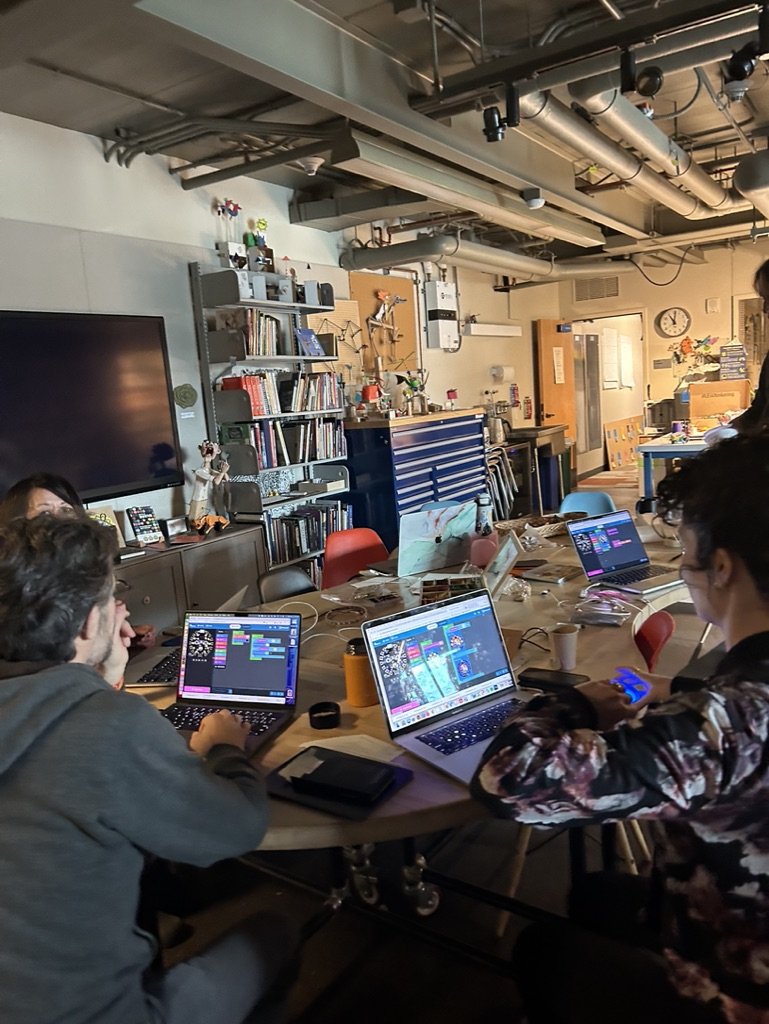Last month I visited the Tinkering Studio–one of our collaborators for the Facilitating Computational Tinkering project–at the Exploratorium for a short artist’s residency. One fun thing we did was participate in an open-ended exploration of the Circuit Playground Express, a microcontroller that the Creative Communities group often uses when we co-design computational tinkering activities and workshops with the ideaLabs at Denver Public Library. The Circuit Playground Express was new-ish to most of the Tinkering Studio team, and there is so much you can do with this microcontroller. Sometimes that makes finding a good starting point difficult. We decided to start with programming the neopixel LED lights built into the Circuit Playground since many of us are interested in tinkering with lights, shadows, and lanterns.
Tinkering with the Circuit Playground Express inside the Learning Studio at the Exploratorium
Here are a few of the directions our tinkering went:
Ryoko began to explore how simple materials like a coffee filter can make a great light diffuser. She also experimented with the capacitive touch feature; animated red lights appeared each time she tapped an alligator clip connected to the Circuit Playground.
Luigi started with an idea–creating a sound-responsive light animation– and went in-depth with the code to make it work like he wanted it to. Luigi found that using the “mapping” code blocks helped him create the desired effect. I loved how Luigi used a coffee cup to house the circuit playground. The plastic lid made for a great light diffuser, and the Circuit Playground fit perfectly into the bottom of the cup.
Luigi uses a coffee cup lid to diffuse the LED lights
Luigi places the Circuit Playground inside of a coffee cup
Sebastian also made great use of upcycled materials; a recycled yogurt container created a base that held the Circuit Playground. Sebastian focused on how he could combine materials like paper and wire with the Circuit Playground to create interesting effects. He created a light-diffusing “screen” using vellum paper and used some wire to position the screen a few inches away from the Circuit Playground. Then, he used wire and a few other materials, like a leafy shape and a figurine, and positioned them between the screen and the lights. As the lights changed colors and turned on or off, it often created the illusion that those shapes were moving behind the screen.
Sebastian experiments with placing objects behind the vellum screen and observes how the light affects the object’s shadow
Sebastian attaches the circuit playground and the the vellum screen to a yogurt container
While this session was short, it generated some exciting sparks that we can continue to tinker with in the future. For example, while the light animations are beautiful and intriguing on their own, using a different input to control the lights, like the tap of a finger or the sound of music, feels even more exciting (sometimes it almost feels magical). Additionally, it was interesting to see the diverse ways that we engaged in computational tinkering. Some went in depth with the code and explored different loops, logic, and functions. Others stuck with one simple program but spent a lot of time experimenting with how to integrate physical materials with the microcontroller. Both of these approaches are essential parts of computational tinkering!
Check out this blog post from the Tinkering Studio, “Shadow Hunting with Photochromic Powder” to see what else we explored during this residency.

